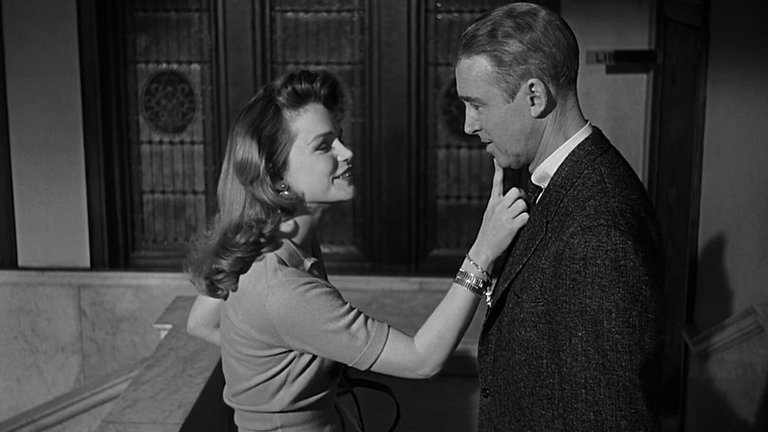Film Review: Anatomy of a Murder (1959)

Otto Preminger occupies a distinguished place in the annals of film history, not only for directing some of Hollywood's grand classics but also for playing a pivotal role in dismantling the notorious MPAA Production Code. This code, which governed content in American films for decades, was increasingly challenged by Preminger's work. Among his most significant contributions to this movement is the 1959 courtroom drama Anatomy of a Murder, a film that stands as one of the most celebrated works in the legal drama genre.
The film is adapted from the eponymous 1958 novel by John C. Voelker, who served as a Michigan Supreme Court judge and wrote under the pen name "Robert Traver." The plot was based by a real-life criminal case from 1952, wherein Voelker defended Lieutenant Coleman A. Peterson, an Army officer accused of murdering bar owner Maurice Chenoweth following an alleged rape of Peterson's wife.
At the centre of Anatomy of a Murder is Paul Biegler, portrayed by James Stewart, who serves as Voelker’s fictional alter ego. Biegler is a former prosecutor turned private practitioner in small-town Michigan, struggling to make ends meet after losing an election. His fortunes change when he reluctantly agrees to defend Lieutenant Frederick Manion (played by Ben Gazzara), who has killed local bar owner Barney Quill shortly after Quill allegedly had beaten and raped Manion’s wife, Laura (played by Lee Remick). As Biegler builds his defence around the concept of temporary insanity, he faces significant challenges; not only does he have to contend with evidence that does not favour his client, but he also faces off against the formidable prosecutor Claude Dancer (George C. Scott), whose intensity adds to the courtroom drama.
From a contemporary standpoint, some elements of Anatomy of a Murder may appear less shocking than they did upon its release. However, at the time, it stirred minor scandal due to its candid references to sex and its use of terms like "rape," "contraceptives," and "climax," which were largely unheard of in Hollywood films under the strictures of the MPAA Production Code. Preminger in 1950s had numerous conflicts with Hollywood censors throughout his career; however, he often emerged victorious—either by releasing films without formal approval or persuading censors to reconsider their rigid standards. His earlier work on The Man with the Golden Arm had already paved the way for more explicit portrayals of drug abuse and societal issues. With Anatomy of a Murder, Preminger further pushed these boundaries, introducing more explicit sexual references that would set a precedent for future filmmakers.
Preminger's directorial choices in Anatomy of a Murder are notable; while his decision to shoot in black-and-white may have been intended to lend an air of authenticity and seriousness compared to more vibrant escapist films of the era, this choice can be seen as less effective from today’s perspective. Nevertheless, he made excellent use of authentic Michigan locations, allowing audiences to connect with characters who feel both unusual and familiar. The jazz soundtrack composed by Duke Ellington (who briefly appears in cameo role) adds an enjoyable layer to the film; however, it occasionally distracts from the narrative and highlights its age.
The script by Wendell Mayes is commendable for establishing a small yet vivid gallery of characters while ensuring that major plot points unfold in a realistic manner. The film's ending is particularly striking; it mirrors real life and presents an unusually ambiguous conclusion for 1950s Hollywood standards. This ambiguity extends to the plot itself—Mayes and Preminger cleverly allow significant events to occur off-screen or be discussed in court, inviting viewers to draw their own conclusions rather than providing clear-cut answers.
Much of the film’s strength lies within its cast. James Stewart delivers a compelling performance as Biegler—a character who embodies cynicism and surprising ruthlessness while navigating his moral obligations as a lawyer. This portrayal marks a significant evolution from Stewart's previous roles as noble idealists, showcasing his ability to tackle more complex characters.
Lee Remick shines as Laura Manion—a role that balances her character's duality as both seductress and victim. Originally intended for Lana Turner, Remick's performance is memorable and nuanced, making Laura one of her standout roles.
Ben Gazzara's portrayal of Lieutenant Manion is equally commendable; his performance effectively transitions him from stage actor to film star as he establishes himself through various character roles in subsequent years.
George C. Scott brings an intense energy to his role as prosecutor Dancer—this performance marked his first Oscar nomination and solidified his reputation as one of Hollywood's formidable actors.
While much of the supporting cast serves their roles adequately—such as Murray Hamilton as the bartender who witnesses the murder and Eve Arden as Biegler’s long-suffering secretary—Arthur O’Connell stands out in his Oscar-nominated role as Biegler’s alcoholic friend and assistant. His character provides much-needed comic relief amidst the film’s serious themes.
For many viewers, Anatomy of a Murder served primarily as entertainment; however, legal professionals in America viewed it through a different lens—as a slice of real life shaped by actual events and penned by a practising attorney. The film is often cited among the best courtroom dramas in Hollywood history and has found its way into law school curricula for educational purposes. Joseph N. Welch—a prominent attorney known for his role in dismantling Senator Joseph McCarthy during televised hearings—delivers a convincing performance as the judge presiding over the case.
Despite its age and length—which some may find excessive—Anatomy of a Murder remains an exceptional film that deserves contemporary audiences' attention just as it did over half a century ago.
RATING: 7/10 (+++)
Blog in Croatian https://draxblog.com
Blog in English https://draxreview.wordpress.com/
InLeo blog https://inleo.io/@drax.leo
Hiveonboard: https://hiveonboard.com?ref=drax
Rising Star game: https://www.risingstargame.com?referrer=drax
1Inch: https://1inch.exchange/#/r/0x83823d8CCB74F828148258BB4457642124b1328e
BTC donations: 1EWxiMiP6iiG9rger3NuUSd6HByaxQWafG
ETH donations: 0xB305F144323b99e6f8b1d66f5D7DE78B498C32A7
BCH donations: qpvxw0jax79lhmvlgcldkzpqanf03r9cjv8y6gtmk9
Posted Using InLeo Alpha